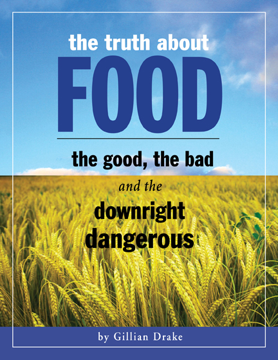The Truth About Food:
The Good, the Bad and the Downright Dangerous
Book Review by Deb Stetson
Published by Shank Painter Publishing, 2013
Reading Gillian Drake's finely written and thoroughly researched book, The Truth About Food: The Good, The Bad and the Downright Dangerous, is at once overwhelming and refreshing.
You may feel both shaken and relieved, for while much of it is frightening (the "downright dangerous" parts) you know it to be true, and Drake's is a voice you can trust. You will find yourself nodding your head while thinking, "I knew that," or, "I had a feeling that was so."
At the same time, however, you may be shocked at some of her suggestions as they go against much of the accepted, conventional "wisdom" of our time. Eat red meat? Heresy! Drink whole, raw milk? Really? Keep reading. This book will open your mind.
Chapter by chapter, The Truth About Food dispels the myths most of us have been living by, revealing truths the food industry may not want us to know.
After reading the book, you may come to the same conclusion this reviewer did: The food industry wants to keep us confused. Carbs are bad – no wait, they are good. Sugar is bad – or maybe it's okay. Low-fat is in. Eggs are bad. Red meat is bad, but protein is good. We are all confused – but we don't have to be.
And we don't have to be overwhelmed. Take this book chapter by chapter, or even section by section, and let the myths and misconceptions go. If you aren't sure, reread the chapter. Drake encourages both research and gut feeling – let this information settle into your life.
Each chapter is accompanied by charts that rank consumption of certain foods in a given category (say Grains, or Meat) according to a level of health. Not surprisingly, the "Western diet" followed by much of the U.S. does not rate high on the health scale Drake sets forth. But if you check each chart, you may well be encouraged to find that some facet of your diet rates fairly well, and that will encourage you to try to improve other areas.
If, however, you find your current diet matches up depressingly well with the lower levels of health delineated on the charts, don't despair. Try taking it one category at a time, making improvements as you go. The beauty of this book is that it gives you a clear road map.
Also helpful is the "Bottom Line" box at the end of each chapter. Even if you don't have the time to read the chapter in detail, here you can get an at-a-glance summary of what foods to include in your diet and which ones to avoid. Then you can go back for more information.
Drake is clearly passionate in her quest to see people eat healthier, and that passion, coupled with her accessible writing style, makes this book very readable. The fact that it is so well researched is wonderful, but it may seem a bit overwhelming. The remedy is simple: Don't read this book too quickly. Focus on one chapter at a time, and implement changes in your diet gradually.

The depth of information here is incredible. You may have heard that Genetically Modified (GM) foods are bad for you, but Drake explains why. You may suspect antibiotics and hormones fed to animals aren't great for the end product, and again, here you can gain a real understanding. Ever wonder if certain foods are a trigger for overeating? You're right – and now you will know why, and how you can avoid that scenario.
Those who already know about the dangers of certain foods are sure to find this book valuable, and to use it as a bible. Those just learning will find it especially helpful. Those new to some of the ideas in the book may be shocked – but also grateful.
It's an education we can all use.
A longtime journalist, Deb Stetson is currently community relations manager for a Cape Cod nonprofit.
She lives in Eastham with her two teenagers, two warring cats and a hyperactive dog.
In her spare time (cue laughter) she writes fiction, and is working on her second novel.
 |
